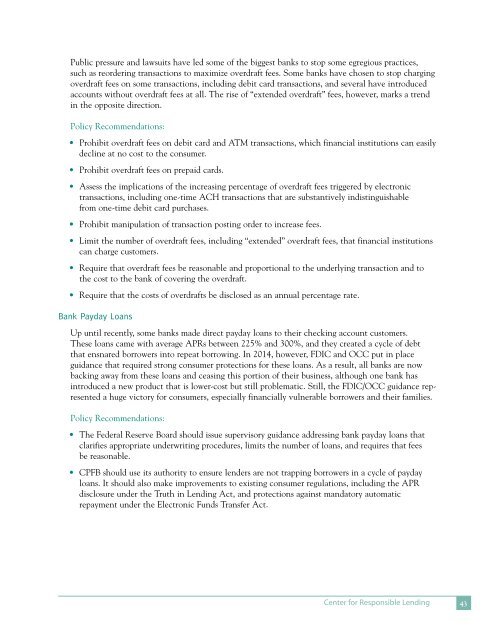Create successful ePaper yourself
Turn your PDF publications into a flip-book with our unique Google optimized e-Paper software.
Public pressure and lawsuits have led some <strong>of</strong> the biggest banks to stop some egregious practices,<br />
such as reordering transactions to maximize overdraft fees. Some banks have chosen to stop charging<br />
overdraft fees on some transactions, including debit card transactions, and several have introduced<br />
accounts without overdraft fees at all. <strong>The</strong> rise <strong>of</strong> “extended overdraft” fees, however, marks a trend<br />
in the opposite direction.<br />
Policy Recommendations:<br />
• Prohibit overdraft fees on debit card and ATM transactions, which financial institutions can easily<br />
decline at no cost to the consumer.<br />
• Prohibit overdraft fees on prepaid cards.<br />
• Assess the implications <strong>of</strong> the increasing percentage <strong>of</strong> overdraft fees triggered by electronic<br />
transactions, including one-time ACH transactions that are substantively indistinguishable<br />
from one-time debit card purchases.<br />
• Prohibit manipulation <strong>of</strong> transaction posting order to increase fees.<br />
• Limit the number <strong>of</strong> overdraft fees, including “extended” overdraft fees, that financial institutions<br />
can charge customers.<br />
• Require that overdraft fees be reasonable and proportional to the underlying transaction and to<br />
the cost to the bank <strong>of</strong> covering the overdraft.<br />
• Require that the costs <strong>of</strong> overdrafts be disclosed as an annual percentage rate.<br />
Bank Payday Loans<br />
Up until recently, some banks made direct payday loans to their checking account customers.<br />
<strong>The</strong>se loans came with average APRs between 225% and 300%, and they created a cycle <strong>of</strong> debt<br />
that ensnared borrowers into repeat borrowing. In 2014, however, FDIC and OCC put in place<br />
guidance that required strong consumer protections for these loans. As a result, all banks are now<br />
backing away from these loans and ceasing this portion <strong>of</strong> their business, although one bank has<br />
introduced a new product that is lower-cost but still problematic. Still, the FDIC/OCC guidance represented<br />
a huge victory for consumers, especially financially vulnerable borrowers and their families.<br />
Policy Recommendations:<br />
• <strong>The</strong> Federal Reserve Board should issue supervisory guidance addressing bank payday loans that<br />
clarifies appropriate underwriting procedures, limits the number <strong>of</strong> loans, and requires that fees<br />
be reasonable.<br />
• CPFB should use its authority to ensure lenders are not trapping borrowers in a cycle <strong>of</strong> payday<br />
loans. It should also make improvements to existing consumer regulations, including the APR<br />
disclosure under the Truth in Lending Act, and protections against mandatory automatic<br />
repayment under the Electronic Funds Transfer Act.<br />
Center for Responsible Lending 43


